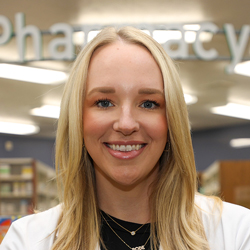On the Cover
Loren Bonner

Rural Americans, who account for about one-fifth of the population, are generally older, have higher rates of obesity and diabetes, and tend to have worse health outcomes. Less access to health care only exacerbates poor health outcomes for many living in these parts of the country.
According to HHS, while 15% of the U.S. population lives in rural areas, less than 10% of physicians practice in these communities. An increasing number of health systems in rural areas are closing their doors, too, mostly because of problems with funding. But pharmacists who provide care to rural Americans are increasingly filling these needed gaps in care.
Studies show that 9 in 10 Americans live within 5 miles of a pharmacy, and patients with greater health needs visited their community pharmacy an average of 35 times per year compared to four visits to their primary care provider and nine visits to specialists.
Most pharmacists who practice in rural America, like Allison Reichert, PharmD, go the extra mile caring for their community. Many patients have Reichert’s cell phone number, and her pharmacy offers an emergency after-hours line. While this may sound shocking, Reichert said it’s actually rare to get a late-night call, since a rural setting means a smaller population. Plus, patients have a personal relationship with Reichert and respect her time.
Pharmacy Today profiled Reichert and two other pharmacists practicing in rural America to get a better understanding of the critical role they are playing in America’s health care infrastructure.

Allison Reichert, PharmD, Illinois
Allison Reichert, PharmD, has been known to call a game of Bingo at the local senior center when she’s there providing vaccines and quarterly BP readings.
“Most [of them are] our patients,” said Reichert, vice president of operations for Bode Drugs in Vienna, IL. Reichert and her father, Carl Bode, RPh, own and operate two rural pharmacies in southern Illinois. One of their stores, located in Mound City, IL, has been in operation for over 100 years. “Spending time with our patients also gives us a chance to answer questions, gives us an opportunity to schedule [a medication therapy management session], and provides a space to be more accessible.”
She makes vaccines more accessible, too. Reichert and her pharmacy team meet patients where they are—physically going out to locations ranging from assisted living facilities to local banks—and offering individuals a full range of vaccines. Not just flu vaccines—COVID-19, pneumonia, and shingles vaccines, too.
“In a rural community, other vaccines can go by the wayside, so we set up pneumonia clinics or shingles clinics, and when we go to them, we find we have more takers,” said Reichert.
Reichert said being accessible is just part of providing care in a rural setting.
“In a rural area, a lot of patients don’t have transportation. It might be 35 miles to the doctor, so that’s something to keep in mind,” said Reichert. “I do feel like we are used as that frontline health care provider,” she said.
The main physician in town is across the parking lot from one of their pharmacies, and they work closely with that provider.
Bode Drugs offers compliance packing for assisted living facilities, but also to people in the community. Most come recommended from the nearby physician. Reichert said compliance packaging is crucial in rural areas. “A patient’s children may have moved away, so it’s comforting for the kids to know their parents are being taken care of in that way.”
Reichert points out that their pharmacies are also full-service retail pharmacies offering not only prescriptions, but OTC products. No large retailers, like Walmart or Target, are nearby. They also deliver medications daily to the corrections facility, which houses federal, state, and local prisoners.
Reichert’s pharmacies have been designated by the State of Illinois as “critical access pharmacies,” which according to the definition in the legislative language of the Illinois Public Aid Code, is an Illinois-based brick-and-mortar pharmacy that is located in a county with fewer than 50,000 residents and that owns fewer than 10 pharmacies.
The Critical Access Pharmacy program was developed to help provide retroactive monetary assistance to qualifying pharmacies for Medicaid prescriptions dispensed, which are significantly under-reimbursed.
“My state payments were always delayed,” said Reichert. “They took months. The critical access [designation] gets [us] guaranteed online payment in addition to a better dispensing fee.”
Reichert said they still have to confront DIR fees and other challenges community pharmacists are faced with these days, but the critical access designation has been helpful.
According to Garth K. Reynolds, BSPharm, RPh, executive director of the Illinois Pharmacists Association, the State of Illinois added additional pharmacies in the rules: the pharmacy must be located in a county with fewer than 50,000 residents, or located in a county with 50,000 or more residents and in an area within Illinois that is designated as a medically underserved area by HHS’s Health Resources and Services Administration.
“We wanted to ensure pharmacies in both rural and urban areas could obtain access to the funding,” said Reynolds. “Each fiscal year, we have had $10 million allocated for the program. This fiscal year will be the first year that we are projected to utilize the entire allocated funds.”
Every day, Reichert feels the impact she makes on her community. “Being a place for patients to simply access health care has been so rewarding,” Reichert said.

Ernest “Tony” Holland, RPh, Alabama
Ernest “Tony” Holland, RPh, who has been a practicing pharmacist for almost 40 years, has worked in chain community pharmacy, academia, and in clinical practice at the U.S. Department of Veterans Affairs (VA) in rural Alabama.
In the Veterans Health Administration (VHA) setting, he said he’s been especially well received.
“You develop a relationship with your patients [and] they lean upon you before they go to their physician,” Holland said. “They look to us to manage therapy and to monitor chronic conditions. We see them first and alert the nurse practitioner they are working with.”
He has provided endless clinical services to veterans ranging from lipid therapy clinics to cholesterol screenings to managing patient’s drug therapy.
According to the U.S. Government Accountability Office, about one-third of veterans enrolled in the VHA live in rural areas.
“The biggest barrier with this population is transportation,” said Holland. “When they need [medication] refills, we have a program [in which] we can be the gap in their next appointment and provide mail service.”
VHA’s Office of Rural Health allocated approximately $245 million dollars for 35 separate initiatives, such as transportation for veterans to VA facilities. However, according to the U.S. Government Accountability Office, VHA’s Office of Rural Health does not communicate all of its funding opportunities across VA programs. As a result, the U.S. Government Accountability Office said VHA may be missing chances to fund research at VA facilities serving rural veterans with unique access issues.
“I see pharmacists as key players in the health care infrastructure in this country,” said Holland. “We are accessible, we have a relationship with the patient, and we can speak with them and their families or caregiver.”
Helping with prevention, screening, and vaccination is part of that infrastructure, according to Holland.
“We are standing in the gap,” said Holland. “Let’s not forget about medication errors. We bridge all those gaps.”
Holland grew up in a small town in rural Alabama, where his local pharmacist influenced his life in a major way.
“In that pharmacy, I saw someone who looked like me. [The pharmacist] knew everyone by name and he worked with you, your condition. He inspired me to become a pharmacist over 40 years ago,” Holland said.
Throughout his career, Holland has received numerous professional awards, and was the first African American president of the Alabama Pharmacists Association, serving from 2001 to 2002.
Holland said these days, compliance issues with patients are the most challenging part of patient care. “So many patients have socioeconomic barriers that may slow them down. It’s a daily challenge for us,” he said.
Holland said there’s an opportunity for telehealth in rural America now more than ever. “We need to increase access and achieve better health outcomes for patients,” said Holland.
He does provide telehealth services within the VHA and has found it to be successful.
According to study findings published in JAMA Network Open on August 14, 2023, states that adopted less-restrictive policies surrounding the use of telepharmacy had fewer pharmacy deserts in the following year.
“More states need to get on board,” said Holland.
Holland has been nominated for a position on the State Board of Pharmacy in Alabama and said if elected, he would recommend favorable telehealth policies to the state government.

Nikki Bryant, PharmD, Georgia
In Preston, GA, Nikki Bryant’s pharmacy serves a town of about 400 residents. The closest chain community pharmacy is over 30 miles away.
“Rural America gets neglected a lot because the populations are so low,” said Bryant, PharmD. “It’s hard to focus energy and resources on these areas, but it doesn’t mean those lives are any less important.”
In fact, Bryant cares for most of her friend’s parents. Those friends have moved away since jobs are limited in the area. Bryant herself lived in other areas of Georgia, working in chain community pharmacy, long term care pharmacy, and hospital pharmacy before eventually making her way back home to Preston.
In 2014, she opened Adams Family Pharmacy in her dad’s local grocery store. The pharmacy was the first in over 60 years in the town of Preston.
“I started delivering medications—no one was doing that at that time,” said Bryant. Her pharmacy now delivers to 12 counties, and 85% of their pharmacy business is delivery. “We started compliance packaging before that was a thing, too,” said Bryant.
In 2019, she opened another pharmacy in the adjacent county. One of the chain community pharmacies there closed, causing the other main pharmacy to take on too many patients, who often had to wait for their medications.
But perhaps Bryant’s biggest undertaking has been the rural health clinic she opened up in Preston.
“I did foresee the need,” said Bryant. “The doctor in Stewart County was getting older and was about to retire, so I knew there was going to be excessive need.”
Bryant’s rural health clinic is the first ever full-time clinic in Webster County history.
Bryant said communication is much more open between pharmacists and other rural health providers.
“Our nurse practitioner in the clinic is my number-one prescriber in our town,” said Bryant. “We work very closely.
For instance, most insurance companies want patients [discharged from a hospital] to be seen within 7 days. When the patient is discharged, we notify the provider, and we follow up on the medication changes. We are very in tune with taking care of the patient, whereas in other pharmacies, that continuity of care may easily get lost.”
Owning and operating a rural health clinic and two pharmacies is challenging, however.
In this pharmacy setting, providing patients with prescriptions, comprehensive medication reviews, immunizations, and recently Paxlovid for COVID-19, is not financially viable, unfortunately.
“Pharmacy reimbursement is hard,” said Bryant. “Last year, we had to add a bakery and some other things just to make it work.”
But if there’s anyone who will make it work, it’s Bryant. She knows how much she is valued by her patients.
“Any negativity from patients just doesn’t happen,” said Bryant. Instead, her patients regularly tell her they don’t know what they would do without her. ■